Spanish Black Radish Care & Propagation Guide
Written by Iris
Nov 08 2021
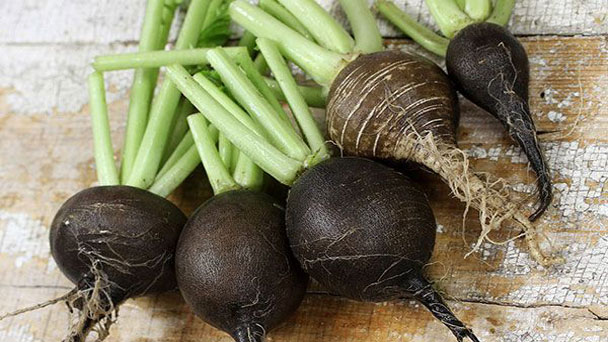
Spanish Black Radish is the perfect addition to your garden. This vegetable has a spicy taste and can add flavor to your salad or stir-fry. Spanish Black Radish also has long-term health benefits: lowering cholesterol and keeping bone marrow healthy, for example. That's not all. Spanish Black Radish has detoxifying properties to help your liver.
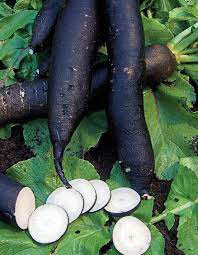
Plant the seeds directly into the place where they will grow.
Leave a furrow ½ to 1 inch (2-3 cm) deep.
Sow regularly, planting about one seed every 1¼ to 1½ inches (3 to 4 cm).
Cover the furrows and do not press down the soil too much.
Regular watering, drizzle.
After the seeds germinate, thin them out. This means removing the weakest buds and keeping only the most vigorous ones, at intervals of six to eight inches (15 to 20 centimeters).
Remove weeds and make sure the ground is free of weeds.
Periodically break the surface gently with a small hoe to allow the water to reach the roots.
You can also choose to sow Spanish black radishes in garden boxes, mix the soil and water them regularly. This will allow you to nibble delicious Spanish black radishes straight from your terrace or balcony. 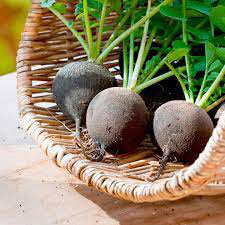
Flea Beetle
Flea beetles are common but damage is not usually fatal.
Flea beetles – Flea beetles feed on the leaves of all brassicas. Small holes in the leaves are the tell-tale sign. They tend to go for younger plants so transplanting from indoors is a good way to avoid them.
Slugs – Slugs can still be active even when it’s cold so keep an eye out for them.
Cutworms – Cutworms, which are the larvae of moths, are awful little blighters. Protect the base of the stem by surrounding it with a plastic plant pot with the bottom cut out.
Aphids – Aphids can also be a problem for radishes so keep an eye out for them. They’re very easy to spot on the undersides of leaves.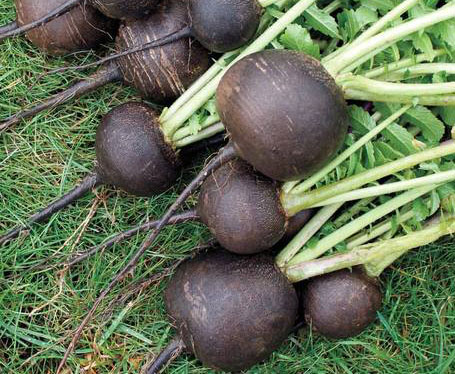
Round Black Spanish. In French they are called Noir Gros Rond D’hiver. A large radish that has been grown at least since the 1500’s, the Round Black Spanish may grow to five inches across. The almost nutty flesh may be eaten raw or cooked. The thin skin makes for dramatically colored round slices. Days to maturity: about 55.
Long Black Spanish, or, in French, Noir Gros Long D’Hiver. Growing to an impressive nine inches long, this slender heirloom radish can be sown all the way into mid-autumn.The flesh packs some firepower.
Round Black. A close relative to the Spanish black radishes, this American heirloom matures in about 35 days, so can be sown in early fall for quick harvest and subsequent storage. Grows to about four inches in diameter.
Nero Tondo. Another black radish close to the Spanish black, this variation seems to resist hot-weather bolting better than any other. So if your weather heats up quickly in late spring, the Nero Tondo may be the best choice for consistent texture and flavor. Maturity in 50 days and can be considered a summer black radish.
Russian Black. Native to the some of the coldest growing conditions imaginable, the Russian heirloom black radish can germinate at close to freezing soil temperatures and forms round mature roots in quite cold soil. In warmer zones, try sowing in fall and harvesting in spring.'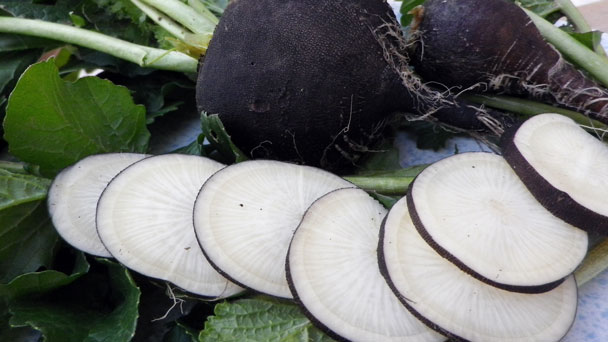
Read Next:
15 Fall Vegetables to Plant for Your Autumn Garden
Where to Grow Spanish Black RadishWhen to Grow Spanish Black RadishHow to Grow Spanish Black RadishHow to Care for Spanish Black RadishSpanish Black Radish Light RequirementsSpanish Black Radish Soil CareSpanish Black Radish WateringSpanish Black Radish Temperature & Humidity CareSpaceSpanish Black Radish Pests & DiseasesSpanish Black Radish VarietiesSpanish Black Radish FAQsWhat is Spanish black radish used for?What does black Spanish radish taste like?What Causes Spanish black radishes with Black Root?
Where to Grow Spanish Black Radish
When they grow too slowly, Spanish black radishes (Raphanus sativus) develop a woody texture and become hotter. Spanish black radishes flourish in well-prepared, loamy, penetrable soil that is well-draining but stays regularly moist. Spanish black radishes need at least 6 hours of full sun a day and soil pH levels of 5.8 to 6.8 are preferred.When to Grow Spanish Black Radish
Spanish black radish is a cold dish that can be planted directly into the ground. You can start planting after all the frost hazards of spring and late summer, once the weather is cool and the ground is dry. Unlike radishes, black radishes take 55 days to ripen after planting.
How to Grow Spanish Black Radish
Planting Spanish black radishes is easy and can be done directly in the ground all summer. Beautiful fresh turnips can be harvested quickly with just a little ground and/or soil mixture and regular watering. Spanish black radishes’ seeds are sown between May and September/October, depending on the climate.Plant the seeds directly into the place where they will grow.
Leave a furrow ½ to 1 inch (2-3 cm) deep.
Sow regularly, planting about one seed every 1¼ to 1½ inches (3 to 4 cm).
Cover the furrows and do not press down the soil too much.
Regular watering, drizzle.
After the seeds germinate, thin them out. This means removing the weakest buds and keeping only the most vigorous ones, at intervals of six to eight inches (15 to 20 centimeters).
Remove weeds and make sure the ground is free of weeds.
Periodically break the surface gently with a small hoe to allow the water to reach the roots.
You can also choose to sow Spanish black radishes in garden boxes, mix the soil and water them regularly. This will allow you to nibble delicious Spanish black radishes straight from your terrace or balcony.

How to Care for Spanish Black Radish
Spanish Black Radish Light Requirements
Spanish black radishes do need plenty of sun, so plant them where they can get six to eight hours of direct sunlight.Spanish Black Radish Soil Care
In addition, Spanish black radishes grow best in moist soil with a pH balance of 5.9 to 6.8.Spanish Black Radish Watering
Keep the soil moist to ensure rapid growth of the Spanish black Radishes for meaty, tasty roots that won't divide. This can be tricky in hot, dry summer weather, so make sure you water your Spanish black Radishes regularly. Keep plants well watered, watering the soil not the leaves, particularly during dry spells and try to keep the weeds down avoid competition.Spanish Black Radish Temperature & Humidity Care
Optimal growing temperature for Spanish black radishes is between 18 and 24°C (65-75°F).Space
Thinning shouldn't be necessary if you sow summer cultivars 2.5cm (1in) apart and winter cultivars 15cm (5in) apart. If thinning is required, do it as soon as possible.Spanish Black Radish Pests & Diseases
Though Spanish black radishes are relatively trouble free, particularly when they’re grown in colder weather when pest activity is generally low, there are a few usual culprits to watch out for.Flea Beetle
Flea beetles are common but damage is not usually fatal.
Flea beetles – Flea beetles feed on the leaves of all brassicas. Small holes in the leaves are the tell-tale sign. They tend to go for younger plants so transplanting from indoors is a good way to avoid them.
Slugs – Slugs can still be active even when it’s cold so keep an eye out for them.
Cutworms – Cutworms, which are the larvae of moths, are awful little blighters. Protect the base of the stem by surrounding it with a plastic plant pot with the bottom cut out.
Aphids – Aphids can also be a problem for radishes so keep an eye out for them. They’re very easy to spot on the undersides of leaves.

Spanish Black Radish Varieties
Here are some of the black radish varieties to look for:Round Black Spanish. In French they are called Noir Gros Rond D’hiver. A large radish that has been grown at least since the 1500’s, the Round Black Spanish may grow to five inches across. The almost nutty flesh may be eaten raw or cooked. The thin skin makes for dramatically colored round slices. Days to maturity: about 55.
Long Black Spanish, or, in French, Noir Gros Long D’Hiver. Growing to an impressive nine inches long, this slender heirloom radish can be sown all the way into mid-autumn.The flesh packs some firepower.
Round Black. A close relative to the Spanish black radishes, this American heirloom matures in about 35 days, so can be sown in early fall for quick harvest and subsequent storage. Grows to about four inches in diameter.
Nero Tondo. Another black radish close to the Spanish black, this variation seems to resist hot-weather bolting better than any other. So if your weather heats up quickly in late spring, the Nero Tondo may be the best choice for consistent texture and flavor. Maturity in 50 days and can be considered a summer black radish.
Russian Black. Native to the some of the coldest growing conditions imaginable, the Russian heirloom black radish can germinate at close to freezing soil temperatures and forms round mature roots in quite cold soil. In warmer zones, try sowing in fall and harvesting in spring.'

Spanish Black Radish FAQs
What is Spanish black radish used for?
Spanish black radish, or Raphanus sativus niger, is a large root vegetable that belongs to the Brassicaceae family, also known as the cruciferous vegetable family. It is commonly used for liver and detoxification support, digestion and cholesterol support, and as an antioxidant booster.What does black Spanish radish taste like?
The intensity of this radish can vary from mildly hot to very pungent and somewhat bitter, depending on the age and size, tasting somewhat like horseradish. The Black radish can be either round or elongated in shape.What Causes Spanish black radishes with Black Root?
The culprit is a fungus-like organism named Aphanomyces raphani. The organism attacks not only radish but other crucifer vegetables.Read Next:
15 Fall Vegetables to Plant for Your Autumn Garden
Latest Updated
- Benefits of Bugleweed - 7 Science-backed Health Benefits
- Bugleweed Dangers & Side Effects - Is It Poisonous?
- How to Plant Evergreen Trees - What You Should Know
- When to Plant Evergreens - Grow Guide for Evergreen Trees
- 12 Wonderful Evergreen Shrubs for Your Garden
- 12 Popular Evergreen Plants with Pictures for Beginners
- When And How To Prune A Lilac Bush Like a Pro
- How to Grow & Care for Lilac Vine (Hardenbergia Violacea)
- Japanese Lilac Tree (Syringa Reticulata) Care & Propagation Guide
- Shumard Oak Pros and Cons - What to Know
Popular Articles
- Winter maintenance of Antirrhinum Majus
- How to Grow Terminalia Mantaly Tree
- How to Grow and Care for Crossostephium Chinense
- How to grow Antirrhinum Majus in spring
- Peristeria Elata (Dove Orchid) Profile: Info & Care Guide
- Underwatered Snake Plant (Sansevieria Trifasciata) - Signs And How To Fix
- How to Care for Brazilian Jasmine Plant (Mandevilla Sanderi)
- How to Grow & Care for Graptopetalum Purple Delight in Summer
- Rosa Chinensis (China Rose): Plant Growing & Care Tips
- How to Care for Baby Sun Rose (Aptenia Cordifolia)